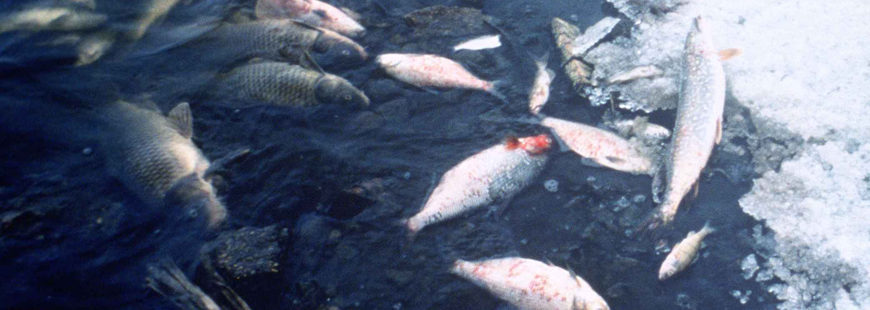Photo: Fish kill, image via USFWS
Fisheries management is simple, right? Just replace what we take and everything is all good. Harvest a fish then patiently wait for Mother Nature to replenish the stock. With all else held constant we’ll reap the benefits of healthy fisheries generation after generation. The problem is that “all else” is NOT held constant. Our fisheries management approach has a ways to go to be considered comprehensive. Fishery managers must consider the array of complicated variables that effect fish mortality and successful reproduction in order to keep fish populations intact.
The 7.3 billion inhabitants of earth are constantly putting more pressure on our planet. The increased strain on the carrying capacity comes with an assortment of other issues. Our climate is changing at rates quicker than we have ever seen. Waters are warming, sea level is rising, currents are changing, and weather is becoming more severe. We have no one to thank for these changes but the collective human race and our cultural habits.
As our population continues to grow, our impact on the planet will likely follow the same trend. The UN projects the world’s population to be 8.5 billion in the year 2030. That means we’ll have about 1.2 billion more mouths to feed and fish will certainly be on the menu. How do we prepare to feed more mouths? For starters, let’s keep evolving by getting better at managing our resources. When it comes to fisheries, our approach needs to be more comprehensive.
Marine dead zones are exploding. In 2004 the UN reported 146 dead zones across the world and in 2008 the number increased to 405. The largest single dead zone on record measures 27,000 square miles, which is slightly larger than West Virginia. These dead zones are low oxygen areas in the ocean caused by excessive nutrients entering our water system from industry, fertilizer, agriculture and pet waste.
If you’ve paid attention to what is happening with Florida’s water then you’re aware these dead zones and red tide events are devastating to sea life, the community and economy. In the Naples Daily News article linked above, Chad Gillis wrote, “The dead [sea] animals are starting to pile up on the sea floor,” after a dive into Florida’s hurting water.
This July, hundreds of dead fish began floating down the Merrimack River in Massachusetts about 20 miles south of my home. Water temps on the river were recorded at 80.3 degrees in Lawrence, which helped to trigger the fish kill. As water warms, it holds less oxygen. When other stressors coincide with low oxygen events, fish kills occur. Events like these are becoming much more common. The resilience of the aquatic life living in our planet’s waters is being put to the test.
How do we account for dead zones, water quality disasters, nutrient loading, habitat loss and climate change in our fisheries plans? I certainly don’t know the answer, but it’s clear that we must continue to adapt our fisheries management approach to account for all of the pressures we put on fish. These variables are not held constant. Prevention of these challenges is the best, long-term solution, but until then, we’ll need to prioritize conservation when managing our fisheries to ensure they remain healthy and abundant.
There’s no doubt we’re in uncharted waters, the horizon is blanketed by fog, and danger lurks nearby. We need to pull back on the throttle and proceed with extreme caution or we’ll end up on the rocks.


